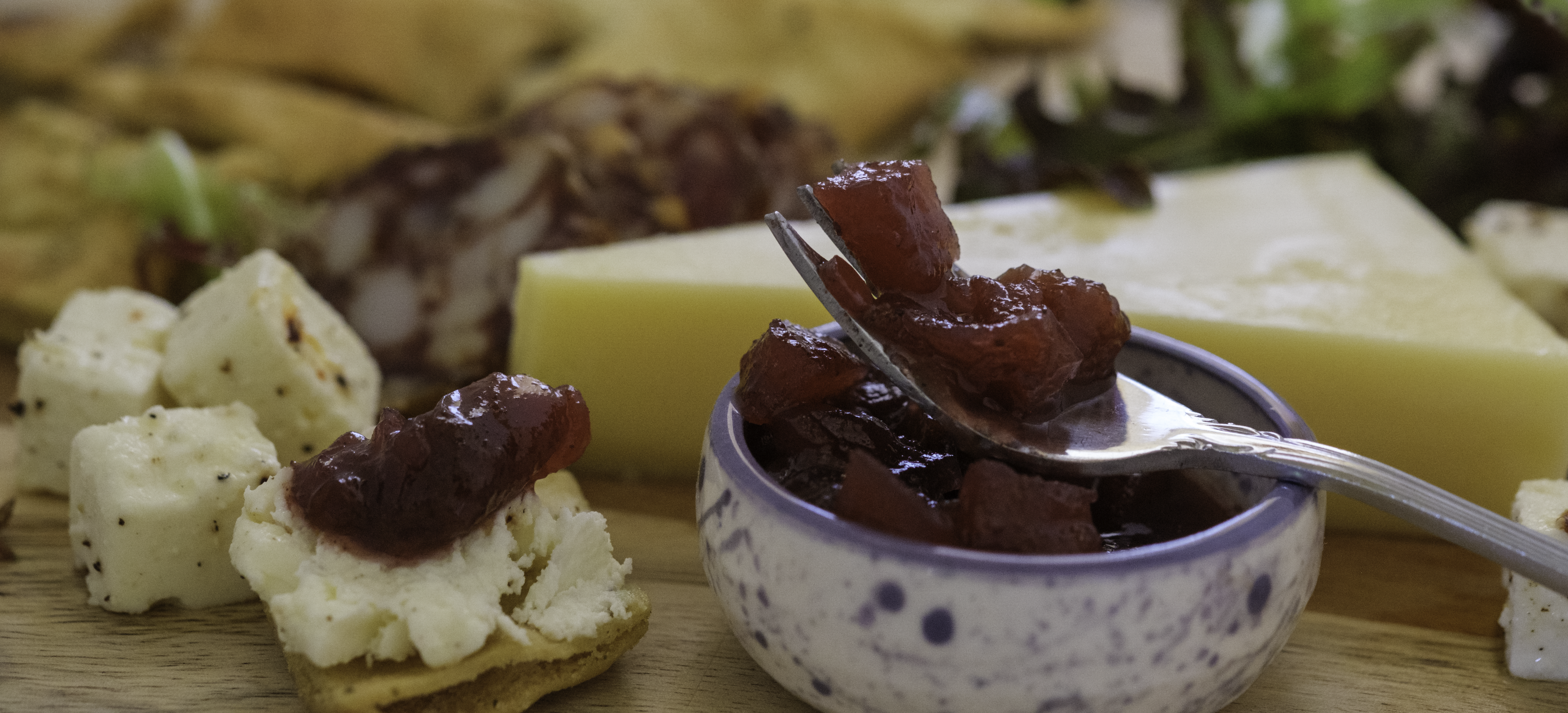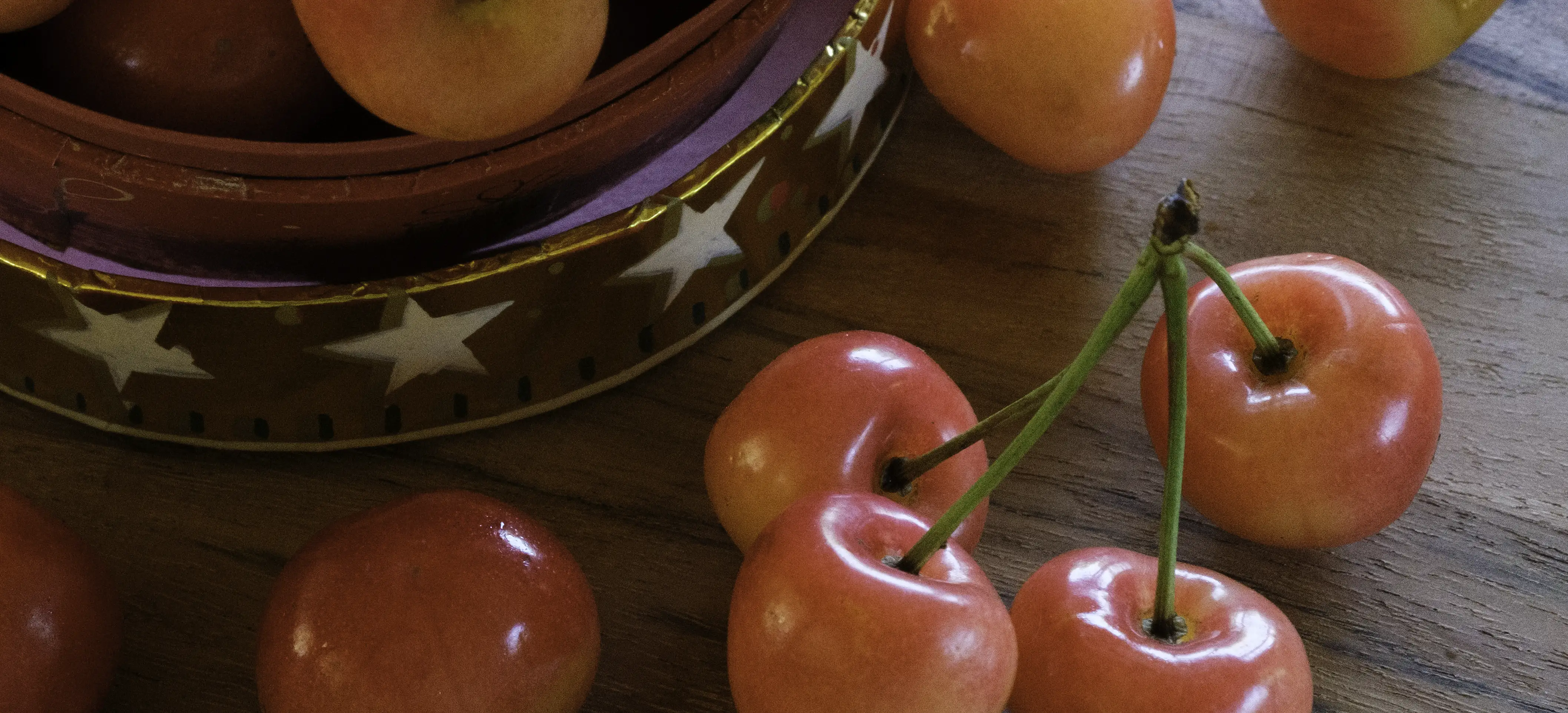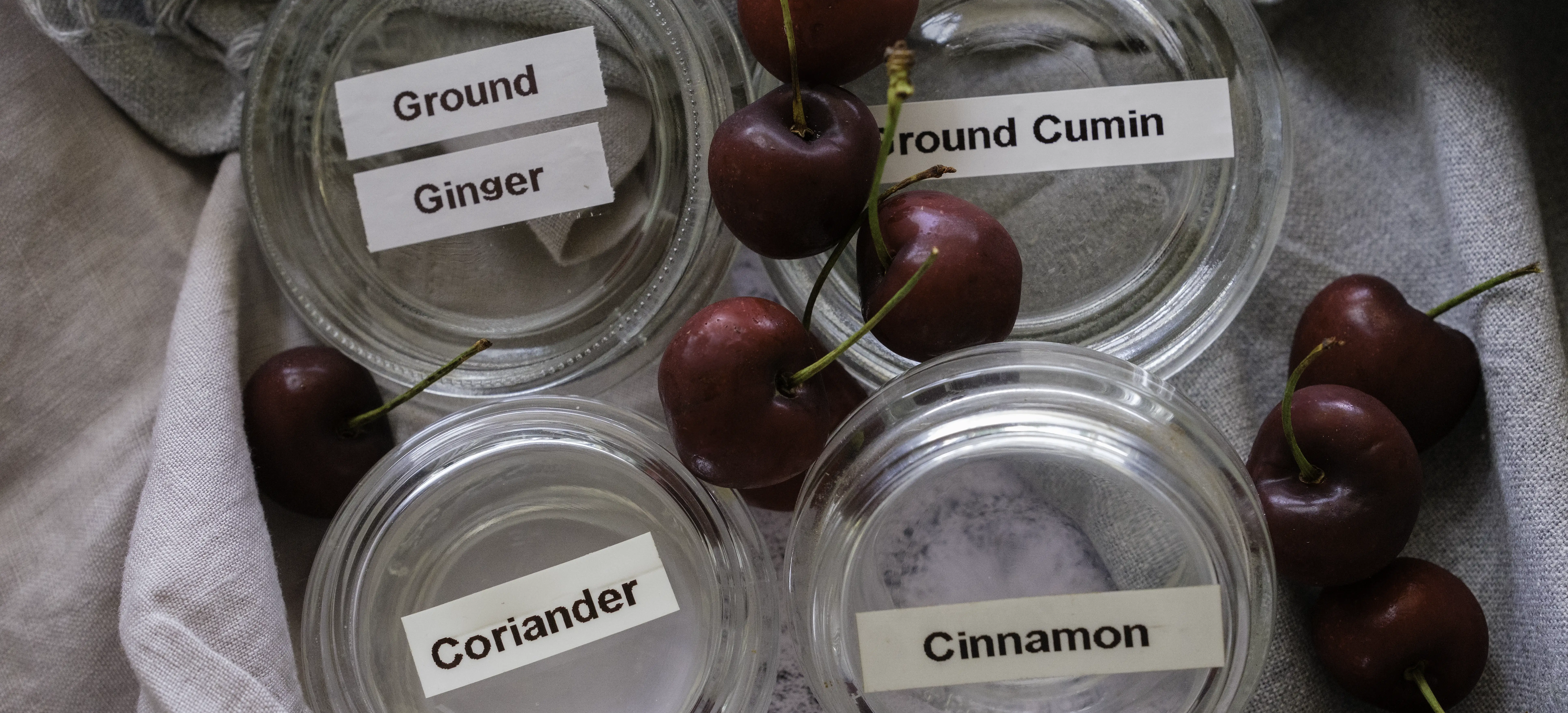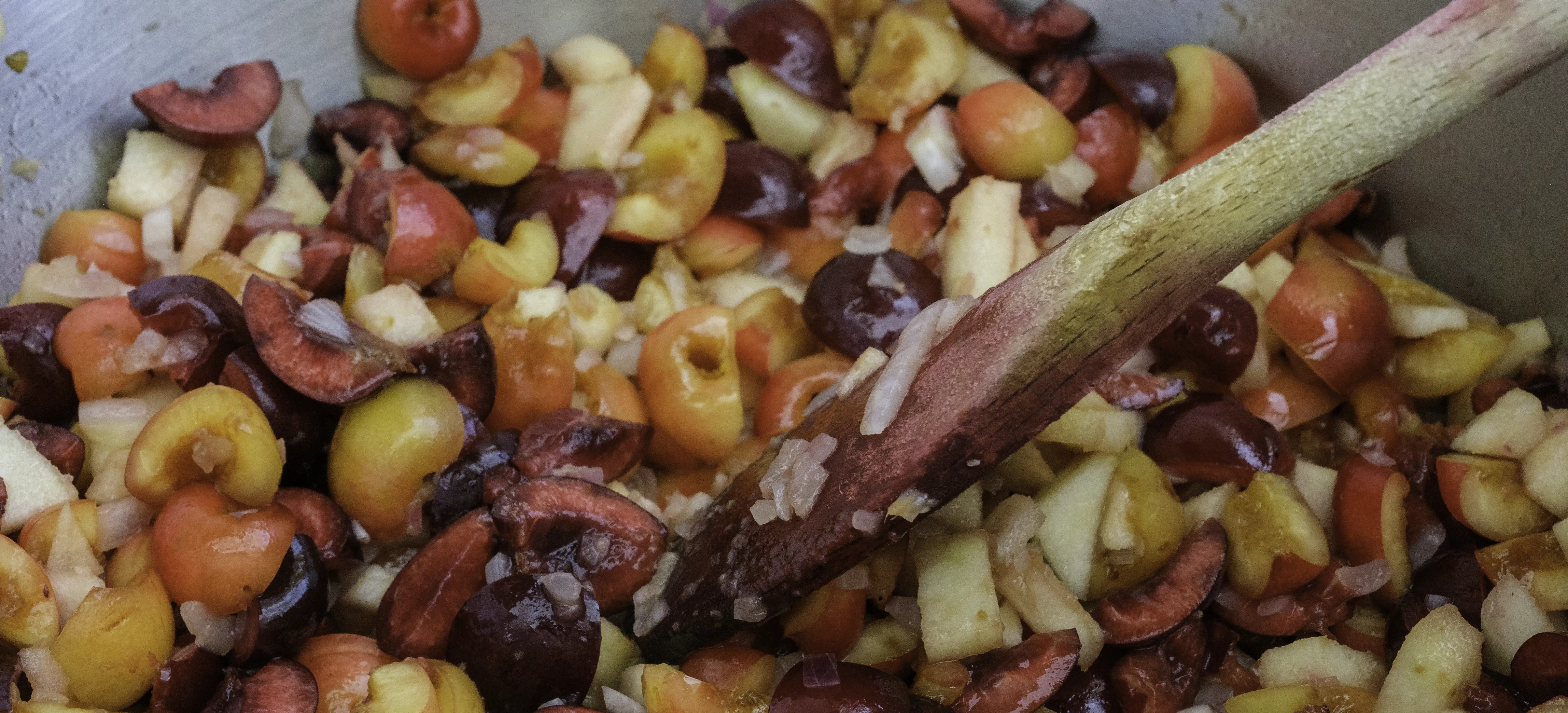Cherry Apple Chutney
- Pickles, Chutney, Relish & Sauces

A mixture of sweet dark and tangy red cherries and cooking apples are infused with Moroccan-style spices to create this stellar summer preserve. I look forward to the cherry season with great anticipation each year. It’s short, and so deliciously sweet that it leaves me a hankering to take just one more handful before walking away from the fruit bowl. It's a perfect pairing partner with duck, turkey and chicken, BBQ's, charcuterie and cheese platter.
Make the most of its short season and jar up a batch of the special preserve. The perfect choice for a special thank you gift for family and friends.
- Preparation Time:
- 40 minutes
- Cooking Time:
- 60 minutes
- Quantity:
- 4 x 200ml jars
PREPARATION
Sterilise glass jars and lids with a protective lining. Have the jars and lids dry, hot and ready for the bottling stage.

INGREDIENTS
- 650g
- Cherries, firm, ripe
- 2, medium
- Cooking apple,
- 100g
- Red onion, peeled, finely chopped
- 10g
- Fresh ginger, peeled
- 1 teaspoon
- Cumin, ground
- 1/2 teaspoon
- Cinnamon, ground
- 1/4 teaspoon
- Coriander, ground
- 100g
- Sugar, white
- 200 ml
- Water
- 400 ml
- Apple cider vinegar
- lug
- Cooking oil

METHOD
Depending on the cherry varieties you can source, it can be made with the dark purple or lighter variety, or an interesting combination, as I have showcased in this recipe.
Wash and gently dry the cherries to remove any shop or garden dust and debris. De-stem and remove the pip. Chop cherries into quarters or smaller if they are large.
Peel, core and finely chop the cooking apple. Finely chop or grate the ginger with a course micro plane.
Place a lug of oil in a preserving pan or heavy bottom stainless steel saucepan. Place over heat and gently fry the onion and fresh ginger until the onion is translucent.
Add the chopped cherry and apple, sugar, spices, salt, water and vinegar. Bring to the boil, then turn down and simmer until the cherry skins are soft and it has a chutney consistency.
Add a small amount of water during the cooking process if the liquid evaporates too quickly before the cherries are cooked.
Stir occasionally, particularly as the mixture thickens, to prevent the chutney from burning on the bottom of the pan.
Use a funnel to pour into hot dry sterilised screw cap sealable bottles, fill to approximately 2.5cm (1 inch) from the top of the jar and seal with hot dry lids. This is the HHH method of sealing - hot preserve, hot jar with a hot lid.
Allow to cool and wipe the jars down to remove any spills during the bottling stage.
Label and store in a cool dark place in the kitchen or pantry.
Allow to mature for at least 4 weeks before eating.
NOTES

- Jars should be clean and hot with lids that have are lined with a protective coating, which can withstand the corrosive action of the vinegar.
- Choose clean ripe fruit. Do not use overripe and never use mouldy fruit as this will produce a poor-quality chutney.
- If you want a chunkier chutney texture, cut the fruit into larger pieces. To ensure even cooking and consistency make sure they are all cut to the same size.
- Seal the chutney while it’s hot with hot dry lids. The HHH method of HOT dry jars, HOT dry lids and HOT preserve creates a vacuum seal as it cools. The “popping” sound, often heard in the kitchen, signals a successfully vacuum sealed jar.
- The HHH method of sealing is preferred as there is reduced risk of contamination prior to sealing.
- Good quality jars should be used in all preserving, particularly when they are processed in a hot water bath. Thin jars often cannot withstand the temperatures and may crack either in the bath or on and or after removal. Avoid the disappointment and invest in some good jars from a homewares or preserves outlet. Select jars that have non-reactive lids as the vinegar solution can cause the lids to rust over time.
- Salt
- Use good quality pickling salt when making pickles and preserves. Many commercial salt brands contain stabilisers and anti-caking agents and often iodide which forms a whitish haze and sediment.
- These additives and in particular iodine can affect the appearance and taste of pickles and preserves during the maturation and storage period. The ingestion of a cocktail of anti-caking chemicals such as calcium silicate, sodium silicoaluminate, tricalcium phosphate, magnesium carbonate, silicon dioxide and yellow prussate of soda, is also unnecessary.
- Read the label before buying and look for salt that is free from any artificial additives. My favourite salt is Olsson Cooking Salt. ( https://www.olssons.com.au/shop)No commercial benefit is received from Olsson Salt.
- Cooking times are an approximation only.
- They are provided as a guideline as cooking times are influenced by the type of pot and its diameter and height, speed of cooking and the ripeness, size, and moisture level of the vegetables. Cooking time will depend upon:
- The size of preserving pan - the broader the pan the quicker the evaporation
- Degree of fruit ripeness - the riper the fruit, the sweeter and juicer the initial chutney will be
- The degree of heat when cooking - the higher the heat, the greater the boil which will produce greater evaporation.
- They are provided as a guideline as cooking times are influenced by the type of pot and its diameter and height, speed of cooking and the ripeness, size, and moisture level of the vegetables. Cooking time will depend upon:
- Types of sugar & vinegar
- The type and colour of the sugar and vinegar used will affect the final colour and flavour of the chutney. Malt vinegar and brown sugar will produce a dark brownish red chutney with a more earthy/molasses background flavour, while white wine vinegar or apple cider and white sugar will produce chutney that has a fresher and brighter flavour. This is a matter of personal choice.
- Take care to only use vinegar which has a 5% minimum acetic acid content. The acetic acid content acts the principal preservative, and a lower percentage will compromise the safety of your preserves. Commercially available vinegar is 5%, however most homemade vinegars do not achieve this level.
- Chutney consistency
- Spoon a little of the mixture on to a plate, the chutney should hold its shape and have a jammy consistency.
- Towards the end of the cooking process, it may be necessary to stir regularly. It is important that the fruit does not stick to the bottom of the pan and burn. Your chutney will be tainted with a burnt flavour will is not very pleasant.
- Knowing your spices
- Cinnamon (Cinnamomum verum)
- Contains sweet and aromatic flavours. It does not taste sweet in itself, rather it enhances the perception of sweetness in other ingredients. It can draw out sweet notes in savory dishes. Cinnamaldehyde is the main flavour compound and is sensed by the temperature sensors on the tongue, giving cinnamon a warming quality.
- Cinnamon sticks keep their flavours for up to a year. Keep in an airtight container and store in a cool dark place in the pantry or kitchen. The lighter brown, thinner more fragile sticks are higher quality.
- Inner layers of bark are dried in the sun and rolled together by hand to make “quills.”
- Cinnamon and cassis are distinctly different in appearance and flavours profile.
- Cumin (Cuminum cyminum)
- Seeds are harvested from annual plants from the small, white, or pink-mauve flowers. The plants are cut down four months after planting then dried and threshed to separate the fruit, which is then further dried.
- The seeds are approximately 6mm long (1/4 inch) and will keep their flavour if stored in a sealed container in a cool, dark place.
- Cumin powder is also available however it loses its flavour and aroma quickly and should be used within a couple of months. It has an earthy herby and woody flavour that is distinctive, highly aromatic and it has a pungent flavour.
- Thought to be native to the Nile Valley and Eastern Mediterranean, its cultivated in India, China, Syria, Türkiye, and Iran.
- Coriander (Coriandrum sativum)
- A versatile spice, that has a bittersweet citrusy flavour with war, floral undertones. Grown as an annual, stalks are cut before the fruits are fully ripe. They are threshed, cleaned, and dried. The stalks and roots are also edible and used frequently in Thai cooking.
- Powders is also available but loses its aroma quickly. It can act as a thickener.
- Native to the Mediterranean and Southern Europe, its cultivated throughout worldwide for its seeds and leaves.
- Ginger (Zingiber officinale)
- Ginger has a hot-spice, citrusy woody taste. It’s available as a fresh underground stem, a rhizome, as a finely ground powder and preserved in sugar.
- The dried and preserved version is used in baking, dried is also used in spice blends whereas fresh ginger is used widely in Asian cuisine. Do not substitute dried ginger for fresh, when specified in a recipe, as the dried form has a stronger and more aromatic flavour.
- When purchasing fresh ginger, avoid older rhizomes with signs of shrivelling as the plan is drying out and the flesh can be fibrous
